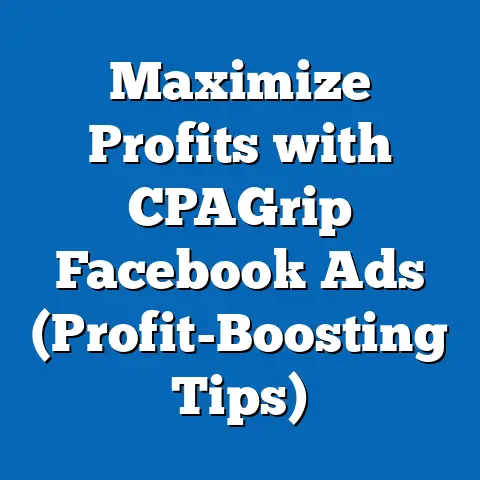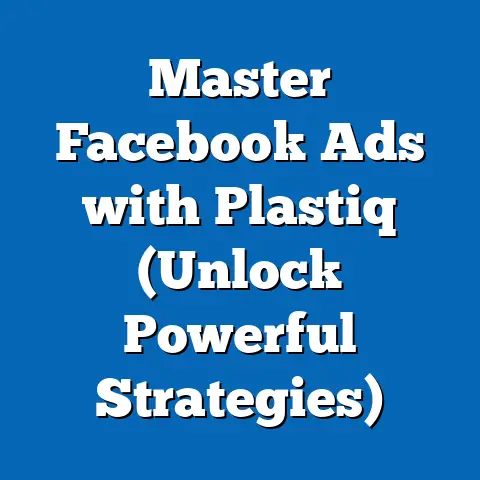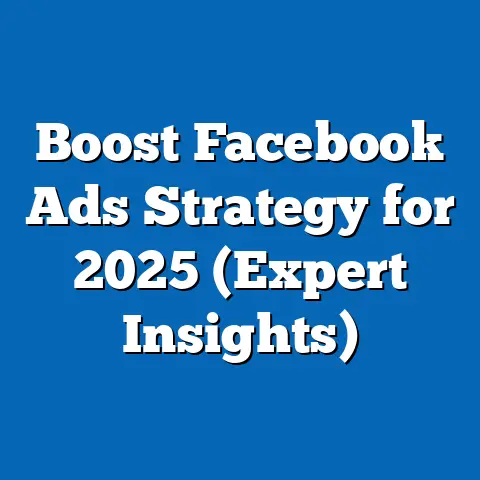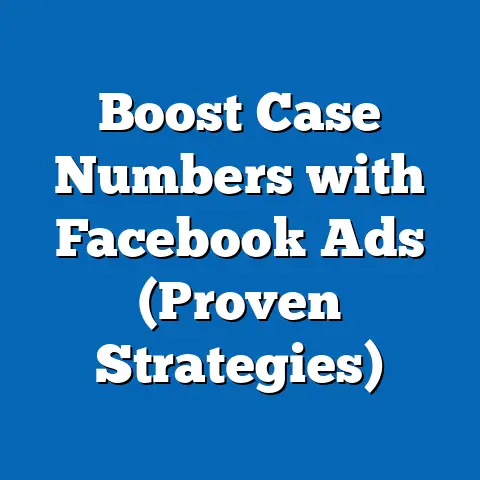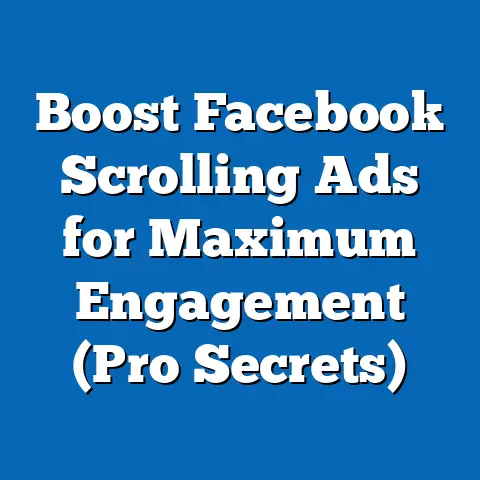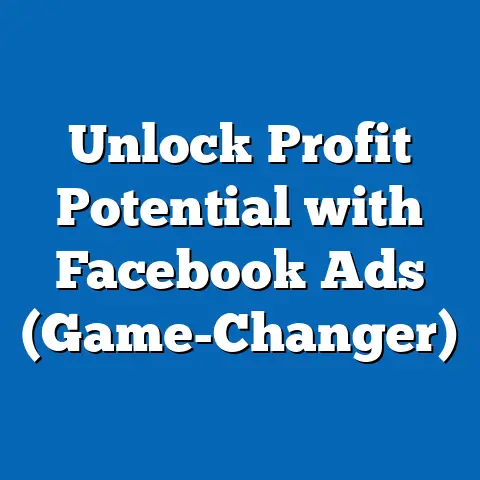Unlock Best Converting Facebook Ads (Proven Strategies)
“Why are my Facebook ads not converting?” This is a question that has haunted me, and I’m sure many of you, throughout my journey in digital marketing. I remember pouring hours into crafting the perfect ad, meticulously selecting my target audience, and setting a budget I thought was reasonable, only to be met with…crickets. It was frustrating, to say the least. The disconnect between the potential I knew Facebook held and the actual results I was seeing felt like a personal affront.
I’ve seen countless business owners and marketers share this sentiment. They invest their hard-earned money, dedicate precious time, and expect to see a return. But instead, they’re left scratching their heads, wondering where they went wrong. Statistics paint a similar picture: a significant percentage of Facebook advertisers feel they aren’t getting the ROI they deserve.
The truth is, Facebook advertising is a complex beast. It’s not enough to simply throw an ad up and hope for the best. The intricacies of the platform, the ever-changing algorithm, and the sheer volume of competition make it challenging to stand out and drive conversions. Many advertisers struggle with understanding these nuances, leading to wasted budgets, missed opportunities, and a general sense of disillusionment.
But don’t despair! I’m here to tell you that high-converting Facebook ads are absolutely achievable. The key lies in understanding the platform, implementing proven strategies, and continuously optimizing your campaigns. In this article, I’m going to share the strategies that have worked for me and for countless other successful Facebook advertisers. We’ll delve into everything from niche-specific targeting to compelling ad copywriting, from leveraging user-generated content to mastering retargeting campaigns. By the end of this guide, you’ll have a clear roadmap to unlock the potential of your Facebook ads and finally see the results you’ve been striving for. Let’s dive in!
Section 1: Understanding the Facebook Ads Ecosystem
Before we jump into the nitty-gritty of creating high-converting ads, it’s crucial to have a solid understanding of the Facebook Ads ecosystem. Think of it as learning the rules of the game before you start playing. This section will cover the power of Facebook advertising, the anatomy of a Facebook ad, and the role of Facebook’s algorithm in determining ad success.
1.1 The Power of Facebook Advertising
Facebook, now under the Meta umbrella, remains a dominant force in the digital advertising landscape. It’s not just a social media platform; it’s a massive advertising engine with unparalleled reach and targeting capabilities.
- Scale and Reach: Facebook boasts billions of active users worldwide. This sheer scale allows you to reach a vast and diverse audience, no matter your niche. I’ve personally seen campaigns that cater to incredibly specific interests thrive on Facebook simply because of the platform’s massive user base.
- Unmatched Targeting: What truly sets Facebook apart is its sophisticated targeting options. You can target users based on demographics (age, gender, location), interests, behaviors, and even life events. This granular targeting allows you to show your ads to the people most likely to be interested in your products or services. I remember one campaign I ran targeting new parents interested in organic baby food. The level of precision was astounding, and the results reflected that!
- Key Statistics: To illustrate the power of Facebook advertising, consider these statistics:
- Facebook reaches approximately 36.7% of the world’s population (Source: Statista).
- The average Facebook user clicks on 12 ads per month (Source: HubSpot).
- Facebook advertising revenue continues to grow year over year, demonstrating its effectiveness for businesses of all sizes (Source: Meta Earnings Reports).
- Facebook reaches approximately 36.7% of the world’s population (Source: Statista).
- The average Facebook user clicks on 12 ads per month (Source: HubSpot).
- Facebook advertising revenue continues to grow year over year, demonstrating its effectiveness for businesses of all sizes (Source: Meta Earnings Reports).
Takeaway: Facebook’s massive scale and sophisticated targeting make it a powerful advertising platform. Understanding its reach is the first step to leveraging its potential.
1.2 The Anatomy of a Facebook Ad
A Facebook ad isn’t just a random collection of words and images. It’s a carefully crafted message designed to capture attention, pique interest, and drive action. Let’s break down the key components:
- Headline: The headline is the first thing people see, and it needs to be attention-grabbing. It should be concise, compelling, and clearly communicate the value proposition. I’ve found that headlines that ask a question or make a bold statement tend to perform well.
- Ad Copy: The ad copy provides more detail about your offer. It should expand on the headline, highlight the benefits of your product or service, and create a sense of urgency. Keep it concise and easy to read, using bullet points or short paragraphs to break up the text.
- Images/Videos: Visuals are crucial for capturing attention in the crowded newsfeed. Use high-quality images or videos that are relevant to your offer and visually appealing. Test different visuals to see what resonates best with your audience. I’ve personally found that videos often outperform images, especially when they tell a story or demonstrate a product in action.
- Call to Action (CTA): The CTA tells people what you want them to do next. Use clear and concise CTAs like “Shop Now,” “Learn More,” “Sign Up,” or “Get Started.” The CTA should be prominent and visually distinct from the rest of the ad.
The Importance of Each Component:
- The headline grabs attention and encourages people to read further.
- The ad copy provides more information and persuades people to take action.
- The visuals capture attention and create an emotional connection.
- The CTA tells people what to do next and drives conversions.
Takeaway: Each component of a Facebook ad plays a critical role in driving conversions. Optimize each element to create a cohesive and compelling message.
1.3 The Role of Facebook’s Algorithm
Facebook’s algorithm, often referred to as “Edgerank” or simply “the algorithm,” is the complex system that determines which content users see in their newsfeeds. Understanding how it works is essential for maximizing ad visibility and performance.
-
How the Algorithm Works: The algorithm considers various factors when ranking content, including:
- Relevance: How relevant the content is to the user’s interests and past interactions.
- Engagement: How much engagement the content receives (likes, comments, shares).
- Recency: How recently the content was published.
- Relationship: The user’s relationship with the person or page that published the content.
-
Relevance Score: Facebook assigns a relevance score to each ad, based on how well it resonates with the target audience. A higher relevance score can lead to lower costs and better ad placement. I’ve seen firsthand how improving my ad’s relevance score can significantly reduce my cost per click (CPC).
- Targeting and the Algorithm: The algorithm uses your targeting criteria to show your ads to the people most likely to be interested in them. The more specific and accurate your targeting, the better your ads will perform.
How the Algorithm Works: The algorithm considers various factors when ranking content, including:
- Relevance: How relevant the content is to the user’s interests and past interactions.
- Engagement: How much engagement the content receives (likes, comments, shares).
- Recency: How recently the content was published.
- Relationship: The user’s relationship with the person or page that published the content.
Relevance Score: Facebook assigns a relevance score to each ad, based on how well it resonates with the target audience. A higher relevance score can lead to lower costs and better ad placement. I’ve seen firsthand how improving my ad’s relevance score can significantly reduce my cost per click (CPC).
Takeaway: Facebook’s algorithm plays a significant role in determining ad visibility and performance. Optimize your ads for relevance and engagement to maximize your reach and minimize your costs.
Section 2: Proven Strategies for Creating High-Converting Ads
Now that we have a solid understanding of the Facebook Ads ecosystem, let’s dive into the proven strategies for creating high-converting ads. These strategies are based on my own experience, as well as the experiences of countless other successful Facebook advertisers.
2.1 Niche-Specific Targeting
One of the most common mistakes I see advertisers make is using broad targeting. They try to reach everyone, and as a result, they reach no one. The key to successful Facebook advertising is niche-specific targeting.
- The Significance of Audience Segmentation: Audience segmentation involves dividing your target audience into smaller, more specific groups based on demographics, interests, behaviors, and other factors. This allows you to create ads that are highly relevant to each segment, which leads to higher engagement and conversion rates. I’ve personally seen conversion rates double (or even triple!) when I’ve switched from broad targeting to highly specific audience segments.
- Creating Custom Audiences: Custom audiences allow you to target people who have already interacted with your business, such as website visitors, email subscribers, or customers. This is a powerful way to retarget people who are already familiar with your brand and more likely to convert.
- Creating Lookalike Audiences: Lookalike audiences allow you to target people who are similar to your existing customers or website visitors. This is a great way to expand your reach and find new customers who are likely to be interested in your products or services. Facebook uses its vast data to identify users who share similar characteristics and behaviors with your source audience (e.g., your existing customer list).
- Layering Interests: Don’t be afraid to layer multiple interests to refine your targeting. For example, instead of just targeting “yoga,” you could target “yoga” AND “meditation” AND “organic food.” This will help you reach a more specific and engaged audience.
Takeaway: Niche-specific targeting is essential for creating high-converting Facebook ads. Segment your audience, create custom and lookalike audiences, and layer interests to reach the right people with the right message.
2.2 Compelling Ad Copywriting Techniques
Even the most visually appealing ad will fall flat if the copy isn’t compelling. Your ad copy needs to grab attention, pique interest, and persuade people to take action.
- Writing Persuasive Ad Copy: Here are some tips for writing persuasive ad copy that resonates with your target audience:
- Focus on Benefits, Not Features: Instead of listing the features of your product or service, focus on the benefits it provides. How will it make people’s lives better?
- Use Strong Action Verbs: Start your sentences with strong action verbs like “Discover,” “Learn,” “Get,” or “Try.”
- Create a Sense of Urgency: Use language that creates a sense of urgency, such as “Limited Time Offer,” “Sale Ends Soon,” or “While Supplies Last.”
- Use Social Proof: Include testimonials, reviews, or other forms of social proof to build trust and credibility.
- Storytelling: People are naturally drawn to stories. Use storytelling to connect with your audience on an emotional level and make your ad more memorable. Share a customer success story, or tell the story of how your product or service was created.
- Emotional Triggers: Tap into your audience’s emotions by using language that evokes feelings of happiness, excitement, fear, or nostalgia.
- Clear CTAs: Your CTA should be clear, concise, and tell people exactly what you want them to do. Use strong action verbs and create a sense of urgency.
- Focus on Benefits, Not Features: Instead of listing the features of your product or service, focus on the benefits it provides. How will it make people’s lives better?
- Use Strong Action Verbs: Start your sentences with strong action verbs like “Discover,” “Learn,” “Get,” or “Try.”
- Create a Sense of Urgency: Use language that creates a sense of urgency, such as “Limited Time Offer,” “Sale Ends Soon,” or “While Supplies Last.”
- Use Social Proof: Include testimonials, reviews, or other forms of social proof to build trust and credibility.
Takeaway: Compelling ad copywriting is essential for driving conversions. Focus on benefits, use strong action verbs, create a sense of urgency, and use storytelling to connect with your audience on an emotional level.
2.3 Visual Elements that Capture Attention
In the crowded newsfeed, visuals are key to capturing attention and stopping people from scrolling.
- The Importance of High-Quality Images and Videos: Use high-quality images and videos that are visually appealing and relevant to your offer. Avoid using stock photos that look generic and impersonal.
- Best Practices for Visuals: Here are some best practices for visuals that enhance ad performance:
- Use Bright, Eye-Catching Colors: Use colors that stand out from the newsfeed and grab attention.
- Show People Using Your Product or Service: This helps people visualize themselves using your product or service.
- Use Text Overlays: Add text overlays to your images or videos to highlight key benefits or features.
- Use Motion Graphics: Motion graphics can be a great way to add visual interest and capture attention.
- Testing Different Visuals: Test different visuals to see what resonates best with your audience. Try different images, videos, and text overlays to see what drives the highest engagement and conversion rates.
- Use Bright, Eye-Catching Colors: Use colors that stand out from the newsfeed and grab attention.
- Show People Using Your Product or Service: This helps people visualize themselves using your product or service.
- Use Text Overlays: Add text overlays to your images or videos to highlight key benefits or features.
- Use Motion Graphics: Motion graphics can be a great way to add visual interest and capture attention.
Takeaway: High-quality visuals are essential for capturing attention and driving conversions. Use bright colors, show people using your product or service, use text overlays, and test different visuals to see what works best.
2.4 A/B Testing and Iteration
A/B testing, also known as split testing, is the process of comparing two versions of an ad (A and B) to see which one performs better. This is an essential part of optimizing your Facebook ad campaigns.
- The Necessity of A/B Testing: A/B testing allows you to make data-driven decisions about your ads. Instead of guessing what works best, you can test different elements and see what actually drives results.
- What to Test: Here are some elements you can test in your Facebook ads:
- Headlines: Test different headlines to see which one grabs the most attention.
- Ad Copy: Test different ad copy to see which one is most persuasive.
- Visuals: Test different images and videos to see which ones resonate best with your audience.
- CTAs: Test different CTAs to see which one drives the most conversions.
- Targeting: Test different targeting options to see which audiences are most responsive.
- Analyzing Results: Use Facebook Ads Manager to track the performance of your A/B tests. Pay attention to metrics like click-through rate (CTR), conversion rate, and cost per conversion.
- Iteration: Once you’ve identified a winning ad, don’t stop there. Continue to test and iterate to improve its performance even further.
- Headlines: Test different headlines to see which one grabs the most attention.
- Ad Copy: Test different ad copy to see which one is most persuasive.
- Visuals: Test different images and videos to see which ones resonate best with your audience.
- CTAs: Test different CTAs to see which one drives the most conversions.
- Targeting: Test different targeting options to see which audiences are most responsive.
Takeaway: A/B testing is essential for optimizing your Facebook ad campaigns. Test different elements, analyze the results, and iterate to continuously improve your performance.
2.5 Leveraging User-Generated Content (UGC)
User-generated content (UGC) is content created by your customers or fans, such as testimonials, reviews, photos, and videos. Incorporating UGC into your ads can be a powerful way to build trust, credibility, and social proof.
- The Benefits of Incorporating UGC:
- Builds Trust and Credibility: People are more likely to trust recommendations from other customers than from the company itself.
- Increases Engagement: UGC is often more engaging than traditional advertising content.
- Reduces Ad Costs: UGC can be more cost-effective than creating your own content.
- Sourcing and Utilizing UGC: Here are some strategies for sourcing and utilizing UGC effectively:
- Run Contests and Giveaways: Encourage customers to submit photos or videos of themselves using your product or service.
- Ask for Testimonials and Reviews: Reach out to satisfied customers and ask them to provide testimonials or reviews.
- Monitor Social Media: Keep an eye on social media for mentions of your brand and identify opportunities to use customer content in your ads.
- Get Permission: Always get permission from the content creator before using their content in your ads.
- Builds Trust and Credibility: People are more likely to trust recommendations from other customers than from the company itself.
- Increases Engagement: UGC is often more engaging than traditional advertising content.
- Reduces Ad Costs: UGC can be more cost-effective than creating your own content.
- Run Contests and Giveaways: Encourage customers to submit photos or videos of themselves using your product or service.
- Ask for Testimonials and Reviews: Reach out to satisfied customers and ask them to provide testimonials or reviews.
- Monitor Social Media: Keep an eye on social media for mentions of your brand and identify opportunities to use customer content in your ads.
- Get Permission: Always get permission from the content creator before using their content in your ads.
Takeaway: Leveraging user-generated content (UGC) can be a powerful way to build trust, credibility, and social proof. Run contests, ask for testimonials, monitor social media, and always get permission before using customer content in your ads.
Section 3: Advanced Strategies for Optimization
Once you’ve mastered the basics of creating high-converting ads, it’s time to delve into some advanced strategies for optimization. These strategies will help you take your Facebook ad campaigns to the next level.
3.1 Retargeting Campaigns
Retargeting is the practice of showing ads to people who have already interacted with your business, such as website visitors, email subscribers, or customers. This is a highly effective way to re-engage people who are already familiar with your brand and more likely to convert.
- The Concept of Retargeting: Retargeting works by placing a tracking pixel (the Facebook Pixel) on your website. This pixel tracks the behavior of your website visitors and allows you to show them targeted ads on Facebook.
- Setting Up Retargeting Campaigns: To set up retargeting campaigns, you’ll need to install the Facebook Pixel on your website. Then, you can create custom audiences based on website visitor behavior, such as people who visited specific pages, added items to their cart, or completed a purchase.
- Dynamic Product Ads: Dynamic product ads are a type of retargeting ad that shows people the specific products they viewed on your website. This is a highly effective way to remind people of what they were interested in and encourage them to complete their purchase.
Takeaway: Retargeting is a highly effective way to re-engage people who are already familiar with your brand and more likely to convert. Install the Facebook Pixel, create custom audiences, and use dynamic product ads to maximize your retargeting efforts.
3.2 Utilizing Facebook Insights and Analytics
Facebook Insights and Analytics provide valuable data about your audience, your ads, and your overall Facebook performance. Analyzing this data can help you identify areas for improvement and optimize your campaigns for better results.
- Interpreting Facebook Insights: Facebook Insights provides data on your audience’s demographics, interests, and behaviors. Use this data to refine your targeting and create ads that are more relevant to your audience.
- Analyzing Ad Performance: Facebook Ads Manager provides detailed data on your ad performance, including impressions, reach, clicks, conversions, and cost per conversion. Use this data to identify your best-performing ads and optimize your campaigns for better results.
- Using Data to Inform Future Strategies: Use the data you collect from Facebook Insights and Analytics to inform your future ad strategies. Identify what’s working and what’s not, and make adjustments accordingly.
Takeaway: Facebook Insights and Analytics provide valuable data that can help you optimize your ad campaigns for better results. Analyze this data to refine your targeting, identify your best-performing ads, and inform your future strategies.
3.3 Budgeting and Bidding Strategies
Budgeting and bidding are crucial aspects of Facebook advertising. Setting the right budget and choosing the right bidding strategy can significantly impact your ad performance and ROI.
- Budgeting Options: Facebook offers two main budgeting options:
- Daily Budget: Sets a daily limit on how much you’re willing to spend on your ads.
- Lifetime Budget: Sets a total budget for the entire duration of your campaign.
- Bidding Strategies: Facebook offers several bidding strategies, including:
- Lowest Cost: Facebook automatically bids to get you the lowest possible cost per result.
- Cost Cap: You set a target cost per result, and Facebook bids to stay within that range.
- Bid Cap: You set a maximum bid for each auction.
- Target Cost: Facebook aims to achieve a specific cost per result, but may exceed it at times.
- Maximizing Ad Spend Effectiveness:
- Start Small and Scale Up: Start with a small budget and gradually increase it as you see positive results.
- Monitor Your Performance: Regularly monitor your ad performance and adjust your budget and bidding strategy as needed.
- Use A/B Testing: A/B test different budgeting and bidding strategies to see what works best for your campaigns.
- Daily Budget: Sets a daily limit on how much you’re willing to spend on your ads.
- Lifetime Budget: Sets a total budget for the entire duration of your campaign.
- Lowest Cost: Facebook automatically bids to get you the lowest possible cost per result.
- Cost Cap: You set a target cost per result, and Facebook bids to stay within that range.
- Bid Cap: You set a maximum bid for each auction.
- Target Cost: Facebook aims to achieve a specific cost per result, but may exceed it at times.
- Start Small and Scale Up: Start with a small budget and gradually increase it as you see positive results.
- Monitor Your Performance: Regularly monitor your ad performance and adjust your budget and bidding strategy as needed.
- Use A/B Testing: A/B test different budgeting and bidding strategies to see what works best for your campaigns.
Takeaway: Budgeting and bidding are crucial aspects of Facebook advertising. Choose the right budgeting option and bidding strategy to maximize your ad spend effectiveness.
3.4 Ad Placement Optimization
Facebook offers a variety of ad placements, including:
- Facebook News Feed: The most common and visible ad placement.
- Instagram Feed: Ads that appear in the Instagram feed.
- Facebook Marketplace: Ads that appear in the Facebook Marketplace.
- Facebook Right Column: Ads that appear in the right column of the Facebook website (primarily on desktop).
- Instagram Explore: Ads that appear in the Instagram Explore tab.
- Facebook Audience Network: Ads that appear on websites and apps outside of Facebook.
-
Messenger Inbox: Ads that appear in the Messenger inbox.
-
Selecting the Most Effective Placements: The most effective ad placement will depend on your target audience and your advertising goals. Test different placements to see what works best for your campaigns.
- Automatic Placements: Facebook offers an “Automatic Placements” option, which allows Facebook to automatically choose the best placements for your ads. This can be a good option for beginners, but I recommend testing different placements manually to see what delivers the best results.
Messenger Inbox: Ads that appear in the Messenger inbox.
Selecting the Most Effective Placements: The most effective ad placement will depend on your target audience and your advertising goals. Test different placements to see what works best for your campaigns.
Takeaway: Facebook offers a variety of ad placements. Test different placements to see what works best for your campaigns, and consider using automatic placements for beginners.
Section 4: Case Studies and Real-World Examples
Let’s examine some real-world examples to illustrate how these strategies can be applied in practice. These case studies will showcase both successful campaigns and common pitfalls to avoid.
4.1 Successful Campaigns and What Made Them Work
I want to share a personal success story. I worked with a local e-commerce business selling handmade jewelry. Their initial Facebook ad campaigns were underperforming, with low click-through rates and minimal conversions. After analyzing their campaigns, I identified several areas for improvement:
- Broad Targeting: They were targeting a very broad audience with limited interest-based targeting.
- Generic Ad Copy: Their ad copy focused on the features of the jewelry rather than the benefits.
- Poor Visuals: They were using low-quality images that didn’t showcase the beauty of their jewelry.
I implemented the strategies we’ve discussed in this article:
- Niche-Specific Targeting: I created custom audiences based on their existing customer list and website visitors. I also created lookalike audiences based on these custom audiences. I further refined the targeting by layering interests related to jewelry, fashion, and handmade crafts.
- Compelling Ad Copy: I rewrote their ad copy to focus on the benefits of their jewelry, such as “Express your unique style with our handcrafted jewelry” and “Find the perfect gift for someone special.” I also incorporated customer testimonials and reviews.
- High-Quality Visuals: I hired a professional photographer to take high-quality images of their jewelry. The images showcased the intricate details and beauty of the pieces.
The results were dramatic. Their click-through rate increased by 300%, their conversion rate increased by 200%, and their cost per conversion decreased by 50%. This case study demonstrates the power of niche-specific targeting, compelling ad copy, and high-quality visuals.
Another great example is a campaign run by a fitness app. They used a combination of video ads showcasing user success stories and highly targeted retargeting. Users who downloaded the app but didn’t subscribe were shown ads with limited-time discounts. This strategy significantly boosted their subscription rates.
Key Takeaways from Successful Campaigns:
- Specificity Wins: The more specific your targeting, the better your results.
- Emotional Connection: Connect with your audience on an emotional level through storytelling and compelling visuals.
- Retargeting is Powerful: Don’t forget to re-engage people who have already shown interest in your brand.
4.2 Common Pitfalls and How to Avoid Them
Even with the best strategies, mistakes can happen. Here are some common pitfalls to avoid in your Facebook ad campaigns:
- Ignoring the Facebook Pixel: Not installing the Facebook Pixel is a cardinal sin. It prevents you from tracking conversions, retargeting website visitors, and creating lookalike audiences.
- Overlooking Mobile Optimization: A large percentage of Facebook users access the platform on mobile devices. Make sure your ads are optimized for mobile viewing.
- Ignoring Ad Fatigue: Showing the same ad to the same audience for too long can lead to ad fatigue. Refresh your ads regularly to keep them engaging.
- Not Monitoring Performance: Failing to monitor your ad performance is like flying blind. Regularly check your metrics and make adjustments as needed.
- Ignoring Negative Feedback: Pay attention to negative comments and feedback on your ads. This can provide valuable insights into what’s not working and how to improve your campaigns.
I once worked on a campaign where the client was adamant about using a single ad creative for months on end. Despite my warnings about ad fatigue, they insisted on sticking with the same image and copy. Unsurprisingly, the ad performance declined steadily over time. This experience taught me the importance of educating clients about the need for regular ad refreshes.
Takeaway: Be aware of these common pitfalls and take steps to avoid them. Regularly monitor your ad performance, refresh your ads, and pay attention to negative feedback.
Conclusion
Facebook advertising can be a powerful tool for driving conversions and growing your business. However, it’s not a “set it and forget it” kind of thing. It requires careful planning, strategic implementation, and continuous optimization. The strategies we’ve discussed in this article – niche-specific targeting, compelling ad copywriting, high-quality visuals, A/B testing, leveraging user-generated content, retargeting campaigns, utilizing Facebook Insights and Analytics, optimizing budgeting and bidding, and mastering ad placement – are all essential for unlocking the potential of your Facebook ads.
Remember, the key to success is to be data-driven, adaptable, and persistent. Continuously test and iterate your campaigns, analyze your results, and make adjustments as needed. Don’t be afraid to experiment and try new things. And most importantly, never stop learning. The Facebook advertising landscape is constantly evolving, so it’s important to stay up-to-date on the latest trends and best practices.
I know that mastering Facebook advertising can seem daunting, but I hope this article has provided you with a clear roadmap to success. Now it’s time to take action! Start implementing these strategies in your own campaigns and see the results for yourself.
So, go forth, create amazing ads, and conquer the Facebook advertising world!
Call to Action:
I’d love to hear about your experiences with Facebook advertising. Share your tips, challenges, and success stories in the comments below. And be sure to follow my page for more insights and updates on Facebook advertising.

